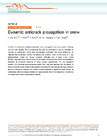Abstract
Continuum numerical modeling of dynamic crack propagation has been a great challenge over the past decade. This is particularly the case for anticracks in porous materials, as reported in sedimentary rocks, deep earthquakes, landslides, and snow avalanches, as material inter-penetration further complicates the problem. Here, on the basis of a new elastoplasticity model for porous cohesive materials and a large strain hybrid EulerianLagrangian numerical method, we accurately reproduced the onset and propagation dynamics of anticracks observed in snow fracture experiments. The key ingredient consists of a modified strain-softening plastic flow rule that captures the complexity of porous materials under mixed-mode loading accounting for the interplay between cohesion loss and volumetric collapse. Our unified model represents a significant step forward as it simulates solid-fluid phase transitions in geomaterials which is of paramount importance to mitigate and forecast gravitational hazards. Show more
Permanent link
https://doi.org/10.3929/ethz-b-000619955Publication status
publishedExternal links
Journal / series
Nature CommunicationsVolume
Pages / Article No.
Publisher
NatureOrganisational unit
09795 - Gaume, Johan / Gaume, Johan
More
Show all metadata
ETH Bibliography
no
Altmetrics



